
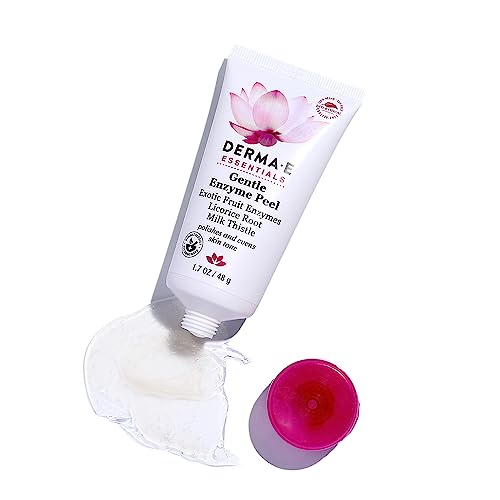
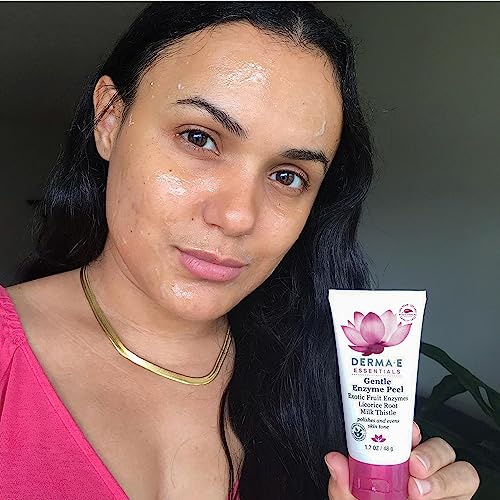
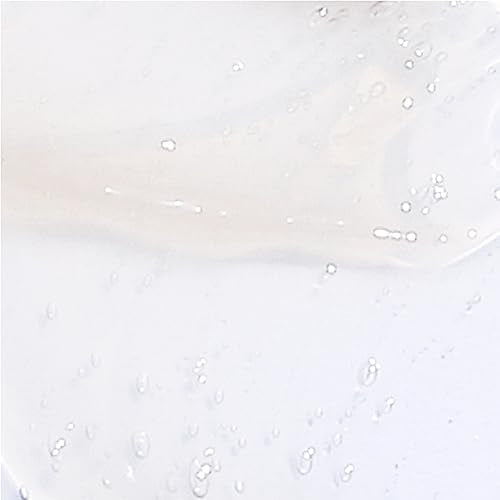
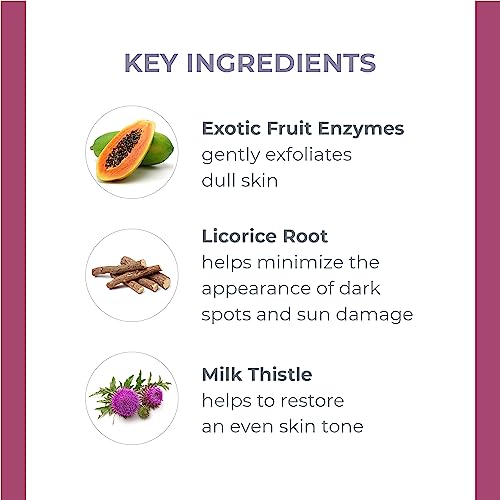
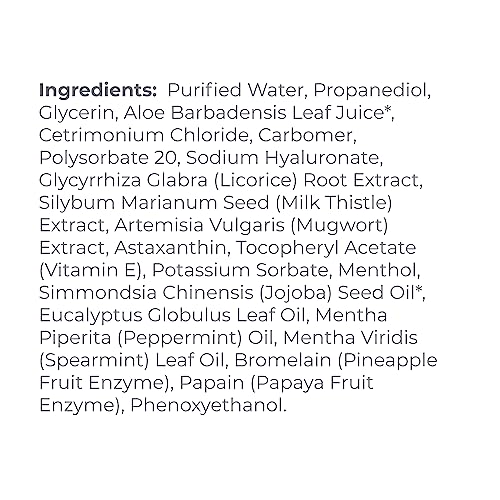
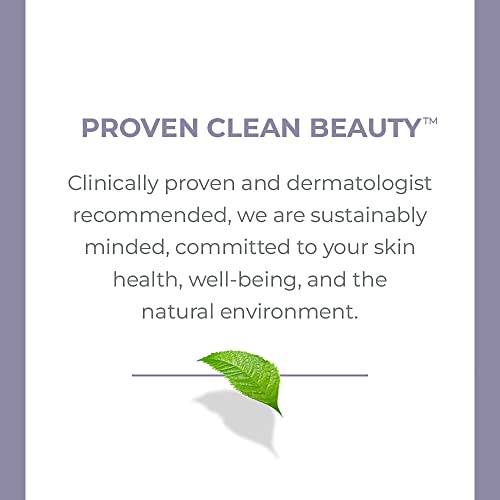
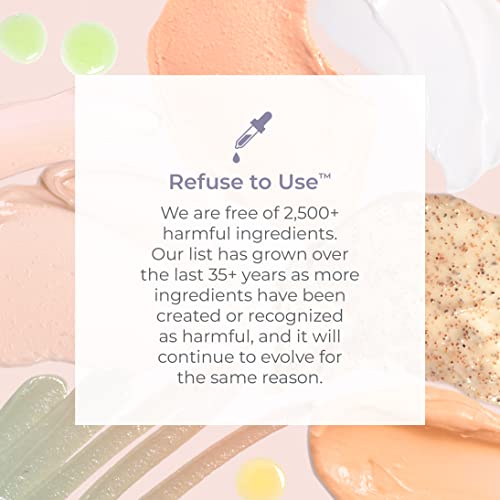
DERMA E Facial Peel - Brightening Exfoliator with Papaya & Milk Thistle - 1.7 oz


Cetrimonium Chloride
High RiskCetrimonium chloride is a quaternary ammonium compound commonly used in personal care products as a conditioning agent and emulsifier. It aids in improving the texture and manageability of hair and skin, serving as a surfactant that reduces surface tension.
Sustai Insights
Cetrimonium chloride provides functional benefits as an effective conditioning agent, enhancing product performance. However, it poses moderate health risks, including potential allergenic reactions and irritation, while being classified with high usage restrictions by regulatory authorities. Environmental concerns include its status as a pollutant with potential bioaccumulative effects. Overall, the ingredient presents a high risk level, necessitating cautious usage and consideration of safer alternatives.
Mentha Spicata (Spearmint) Oil
High RiskMentha spicata, commonly known as spearmint oil, is an essential oil derived from the leaves of the spearmint plant. It is often used in various products for its aromatic properties, flavoring, and potential therapeutic benefits.
Sustai Insights
Spearmint oil offers functional benefits, including flavor enhancement and potential antimicrobial properties. However, it is associated with a high risk of allergic reactions, and its use can lead to skin and respiratory irritation. Environmental concerns include potential pollutant effects, although it is not considered bioaccumulative. Regulatory advisories highlight its restricted use in verified products. Overall, the risk level is assessed as high, suggesting cautious use and consideration of safer alternatives.
Mentha Piperita (Peppermint) Oil
High RiskMentha piperita (peppermint) oil is a volatile oil extracted from the leaves of the peppermint plant, known for its strong aroma and flavor. It is commonly used in cosmetics and personal care products for its cooling properties and fragrance enhancement.
Sustai Insights
Peppermint oil offers functional benefits such as antimicrobial properties and a soothing sensation on the skin. However, it is associated with a high potential for allergies and skin irritation. Regulatory bodies impose certain restrictions on its use due to these concerns. The overall risk level is assessed as high, warranting caution in usage, especially for sensitive populations. Alternatives like spearmint oil may provide similar benefits with potentially lower irritation risks.
Menthol
High RiskMenthol is a scent ingredient naturally found in mint oils. It is primarily used for its cooling sensation and fragrance properties in various products, including personal care and cosmetics, providing a characteristic minty aroma.
Sustai Insights
Menthol offers functional benefits such as providing a cooling effect and enhancing fragrance in formulations. However, it has a high allergenic potential and can cause irritation in sensitive individuals. Regulatory agencies have noted restrictions on its use due to these safety concerns. Environmentally, menthol poses low risks, but cumulative exposure from multiple sources can occur. Overall, menthol is considered high risk due to its allergenic properties and potential for irritation, highlighting the need for careful usage and consideration of alternatives.
Papain
Medium RiskPapain is a proteolytic enzyme isolated from the papaya fruit, primarily used in cosmetic and personal care products for its ability to break down proteins. It serves functions such as exfoliation and skin softening, contributing to product efficacy in skincare formulations.
Sustai Insights
Papain offers functional benefits as an effective exfoliant and skin softener, potentially enhancing product performance. However, it is associated with high irritation risks for skin, eyes, and lungs, along with a moderate potential for causing allergies. Regulatory restrictions exist for verified products containing papain, reflecting concerns about its health impacts. Environmental risks are minimal, with no significant pollutant or bioaccumulation potential identified. Overall, papain presents a medium risk, and safe usage practices should be followed, with alternatives like less irritating enzymes available for consideration.
Bromelain
Medium RiskBromelain is a mixture of enzymes found in pineapple stems and fruit, primarily functioning as a proteolytic enzyme, which helps in the breakdown of proteins. It is commonly used in dietary supplements and cosmetic formulations for its potential anti-inflammatory and digestive benefits.
Sustai Insights
Bromelain offers functional benefits as a proteolytic enzyme, aiding digestion and reducing inflammation. However, it poses moderate health risks, including potential allergic reactions and high irritation levels for skin and respiratory systems. Environmental concerns are minimal, with no significant pollutant or bioaccumulation risks noted. Regulatory status shows some restrictions on product formulations, indicating a medium risk overall. Safe usage practices are recommended, particularly for sensitive populations, while alternatives such as papain may provide similar benefits with potentially lower risks.
Glycyrrhiza Glabra (Licorice) Root Extract
Medium RiskGlycyrrhiza glabra (licorice) root extract is derived from the root of the licorice plant and is commonly used in cosmetic formulations for its soothing properties. It is known for its ability to impart a sweet flavor and is utilized for its skin-brightening and anti-inflammatory effects.
Sustai Insights
Licorice root extract offers functional benefits such as skin soothing and anti-inflammatory properties, making it valuable in cosmetic formulations. It is sourced sustainably; however, it poses low to moderate health risks, including potential allergenic effects and endocrine disruption. Environmental concerns are minimal, with no significant pollutant or bioaccumulation potential. Regulatory bodies restrict its use in certain concentrations, leading to a moderate overall risk assessment. Safe usage practices should be adhered to, and alternatives like chamomile extract may be considered for those seeking lower risk options.
Eucalyptus Globulus (Eucalyptus) Leaf Oil
Medium RiskEucalyptus globulus leaf oil is a volatile oil derived from the leaves of the eucalyptus tree, primarily used for its aromatic properties and as a potential antimicrobial agent in various products.
Sustai Insights
Eucalyptus globulus leaf oil offers functional benefits like fragrance and potential antimicrobial properties, supporting product efficacy. However, it presents high allergenic potential and moderate irritation concerns, which may pose health risks. Environmental risks include possible pollution and bioaccumulation. Regulatory restrictions are in place regarding its use in certain products. Overall, the risk level is medium, necessitating caution in usage and consideration of alternatives like tea tree oil or peppermint oil.
Glycerin
Medium RiskGlycerin (also called glycerol) is a naturally occurring compound commonly used in personal care and cosmetic products. It functions as a humectant, attracting moisture to the skin, and is also utilized as a solvent and emollient to enhance product texture and stability.
Sustai Insights
Glycerin is valued for its effective moisturizing properties and biodegradability, making it a widely accepted ingredient in formulations. It poses low health risks, including low concerns for carcinogenicity and allergies. However, moderate use restrictions exist due to regulatory guidelines. While glycerin does not significantly contribute to environmental pollution, its production process should be ethically sourced. Overall, glycerin holds a medium risk level, emphasizing the importance of safe usage practices and considering sustainable alternatives.
Phenoxyethanol
Medium RiskPhenoxyethanol is a preservative used in cosmetics and personal care products to prevent microbial growth and extend shelf life. It is commonly found in formulations such as lotions, creams, and serums.
Sustai Insights
Phenoxyethanol serves effectively as a preservative, ensuring product stability and safety by inhibiting microbial growth. It is considered to have low health risks regarding carcinogenicity, allergies, and reproductive toxicity. However, moderate use restrictions exist, and regulatory bodies have advised caution in specific applications. Environmental concerns include its potential as a pollutant, although it is not highly bioaccumulative. Overall, the ingredient presents a medium risk level, with safe usage practices recommended and alternative preservatives available for those seeking greener options.
Potassium Sorbate
Medium RiskPotassium sorbate is a potassium salt of sorbic acid, primarily used as a preservative in food and cosmetic products. It inhibits the growth of molds, yeast, and some bacteria, extending the shelf life of products. It is commonly found in various formulations due to its effectiveness and low toxicity.
Sustai Insights
Potassium sorbate serves as an effective preservative, preventing microbial growth in food and cosmetic products, which is vital for safety and longevity. Although it has a low risk of carcinogenicity and developmental toxicity, there is a moderate concern regarding allergies and immunotoxicity. Environmentally, it poses minimal risks as it is not significantly bioaccumulative. Regulatory agencies have verified its use, although some products may face restrictions. Overall, it is assessed as a medium risk ingredient, with safe usage practices recommended, and alternatives such as natural preservatives could be considered.
Tocopheryl Acetate
Medium RiskTocopheryl acetate is a chemical compound that serves primarily as a form of Vitamin E. It is used in cosmetic and personal care products for its antioxidant properties and to enhance skin stability and moisture.
Sustai Insights
Tocopheryl acetate is valued for its functional benefits, including acting as an antioxidant and skin conditioning agent. It is generally considered to have low carcinogenicity and reproductive toxicity risk, although it poses a moderate concern for allergies. Environmental risks are minimal, with no significant pollutant or bioaccumulation potential noted. Regulatory bodies have not imposed significant restrictions. Safe usage practices should be followed, particularly regarding enhanced skin absorption. Alternatives like natural Vitamin E may provide similar benefits with potentially lower allergenic properties. Overall, this ingredient presents a medium risk assessment.
Sodium Hyaluronate
Low RiskSodium hyaluronate is the sodium salt of hyaluronic acid, a naturally occurring polysaccharide in the body. It functions primarily as a humectant in cosmetic formulations, retaining moisture and enhancing skin hydration, contributing to the overall texture and appearance of products.
Sustai Insights
Sodium hyaluronate offers several functional benefits, including effective moisture retention and skin hydration. It is considered safe with low concerns regarding carcinogenicity, allergies, or reproductive toxicity. Environmentally, it is not classified as a pollutant or bioaccumulative. Regulatory bodies do not impose significant restrictions on its use. Overall, it is assessed as low risk, making it a favorable ingredient in cosmetic formulations.
Artemisia Vulgaris (Mugwort) Extract
Low RiskArtemisia vulgaris extract is derived from the mugwort plant, commonly used in traditional medicine and cosmetics. It is known for its potential soothing properties and is often incorporated into formulations for its aromatic and preservative qualities.
Sustai Insights
Artemisia vulgaris extract offers functional benefits such as antioxidant properties and potential soothing effects on the skin. It is sustainably sourced and not currently associated with significant health risks, including low concerns for carcinogenicity and allergens. Environmental risks are minimal, with no evidence of bioaccumulation or pollution. Regulatory assessments indicate no current restrictions on its use. Overall, the risk level is low, and it can be safely used in various formulations. Alternatives may include other botanical extracts with similar properties.
Silybum Marianum (Blessed Thistle) Seed Extract
Low RiskSilybum marianum (blessed thistle) seed extract is derived from the seeds of the Silybum marianum plant. It is commonly used in various cosmetic and personal care products for its potential benefits, primarily in skin health and nourishment.
Sustai Insights
Silybum marianum seed extract is recognized for its antioxidant properties, which can benefit skin health. It is sustainably sourced and not associated with significant health risks, including carcinogenicity, allergies, or reproductive toxicity. While it poses low environmental risks, it is not known to contribute to pollution or bioaccumulation. Regulatory bodies have no current restrictions on its use. Overall, the risk level is assessed as low, and it can be considered a safe ingredient in formulations, with no significant adverse effects noted.
Carbomer
Low RiskCarbomer is a large polymeric chemical compound primarily used as a thickening agent in various cosmetic and personal care products. It enhances the texture and stability of formulations, making it effective in creams, gels, and lotions.
Sustai Insights
Carbomer serves as an effective thickening agent, improving product texture and stability. It is considered low-risk concerning health concerns such as carcinogenicity, allergenicity, and reproductive toxicity. While irritation may occur with skin or eye contact, the overall health and environmental risks are minimal. Regulatory bodies have not placed significant restrictions on carbomer, supporting its safety for use in formulations. Safe usage practices should be followed to minimize irritation potential. Alternatives like xanthan gum or guar gum may provide similar benefits with a natural profile. Overall, the ingredient is assessed as low risk.
Astaxanthin
Low RiskAstaxanthin is a carotenoid pigment found in various marine organisms, including algae, shrimp, and salmon. Its primary function in products is as a natural colorant and antioxidant, often used in dietary supplements and cosmetics for its purported health benefits.
Sustai Insights
Astaxanthin offers functional benefits as a potent antioxidant and natural colorant, contributing to skin health and UV protection. It is sustainably sourced from marine life and does not exhibit significant health risks, with low concerns related to carcinogenicity, allergy, or reproductive toxicity. Environmental risks are minimal, with no evidence of bioaccumulation. Regulatory bodies, including the FDA, do not impose restrictions on its use. Overall, the risk level is assessed as low, and it is advisable to use astaxanthin within established safe concentrations. Alternatives include other natural antioxidants like lutein or zeaxanthin.
Propanediol
Low RiskPropanediol is a glycol compound commonly used in cosmetic and personal care products as a solvent, humectant, and skin-conditioning agent. It serves to enhance the texture and moisture retention of formulations, contributing to overall product efficacy.
Sustai Insights
Propanediol offers functional benefits such as effective moisture retention and improved product application. It is considered low-risk in terms of health concerns, with minimal associations with carcinogenicity, allergies, or reproductive toxicity. Environmentally, it has low pollutant potential and is not bioaccumulative. Regulatory bodies have not placed restrictions on its use. Despite concerns regarding enhanced skin absorption and potential endocrine disruption, the overall assessment indicates low risk. Safe usage practices should be followed, and alternatives like glycerin or other plant-based humectants can be considered.
Water
Low RiskWater is a clear, colorless liquid essential for various biological processes. It serves as a solvent in formulations, facilitating the dissolution of other ingredients and enhancing product texture and application. Additionally, water plays a crucial role in hydration and is a key component in many cosmetic and personal care products.
Sustai Insights
Water is an effective solvent and hydrator, contributing to the texture and efficacy of formulations. It is biodegradable and generally regarded as safe, with low concerns regarding carcinogenicity, allergies, and reproductive toxicity. However, excessive water usage can lead to environmental concerns, particularly regarding resource depletion. Regulatory bodies do not impose restrictions on water use in cosmetics. Overall, the risks associated with water are low, making it a safe and essential ingredient.
Simmondsia Chinensis (Jojoba) Seed Oil
Low RiskSimmondsia chinensis (jojoba) seed oil is extracted from the seeds of the jojoba plant. It is commonly used in cosmetics for its moisturizing properties and ability to mimic human sebum, making it beneficial for skin and hair care formulations.
Sustai Insights
Jojoba seed oil offers functional benefits such as effective moisturization and emollience, contributing to skin hydration and smoothness. It is sustainably sourced and biodegradable. Health risks are low, with minimal concerns regarding carcinogenicity, allergies, and reproductive toxicity. Environmental risks are also low, as it does not significantly contribute to pollution or bioaccumulation. Currently, there are no regulatory restrictions on its use. Overall, the risk level is low, and it is considered a safe ingredient with no significant adverse effects.
Aloe Barbadensis (Aloe Vera) Leaf Juice
Low RiskAloe barbadensis (aloe vera) leaf juice is derived from the succulent aloe vera plant, known for its hydrating and soothing properties. It is commonly used in cosmetic formulations for its moisturizing effects and is often included in products aimed at skin care and healing.
Sustai Insights
Aloe vera leaf juice offers functional benefits as a moisturizer and skin soothing agent, while being sustainably sourced and biodegradable. Health risks are low, with minimal concerns regarding carcinogenicity, allergies, and reproductive toxicity. Environmental impact is also low, with no significant pollutants identified. Regulatory agencies impose few restrictions. Overall, the ingredient poses a low risk, making it a favorable choice in cosmetic formulations.
Cetrimonium Chloride
High RiskCetrimonium chloride is a quaternary ammonium compound commonly used in personal care products as a conditioning agent and emulsifier. It aids in improving the texture and manageability of hair and skin, serving as a surfactant that reduces surface tension.
Sustai Insights
Cetrimonium chloride provides functional benefits as an effective conditioning agent, enhancing product performance. However, it poses moderate health risks, including potential allergenic reactions and irritation, while being classified with high usage restrictions by regulatory authorities. Environmental concerns include its status as a pollutant with potential bioaccumulative effects. Overall, the ingredient presents a high risk level, necessitating cautious usage and consideration of safer alternatives.
Mentha Spicata (Spearmint) Oil
High RiskMentha spicata, commonly known as spearmint oil, is an essential oil derived from the leaves of the spearmint plant. It is often used in various products for its aromatic properties, flavoring, and potential therapeutic benefits.
Sustai Insights
Spearmint oil offers functional benefits, including flavor enhancement and potential antimicrobial properties. However, it is associated with a high risk of allergic reactions, and its use can lead to skin and respiratory irritation. Environmental concerns include potential pollutant effects, although it is not considered bioaccumulative. Regulatory advisories highlight its restricted use in verified products. Overall, the risk level is assessed as high, suggesting cautious use and consideration of safer alternatives.
Papain
Medium RiskPapain is a proteolytic enzyme isolated from the papaya fruit, primarily used in cosmetic and personal care products for its ability to break down proteins. It serves functions such as exfoliation and skin softening, contributing to product efficacy in skincare formulations.
Sustai Insights
Papain offers functional benefits as an effective exfoliant and skin softener, potentially enhancing product performance. However, it is associated with high irritation risks for skin, eyes, and lungs, along with a moderate potential for causing allergies. Regulatory restrictions exist for verified products containing papain, reflecting concerns about its health impacts. Environmental risks are minimal, with no significant pollutant or bioaccumulation potential identified. Overall, papain presents a medium risk, and safe usage practices should be followed, with alternatives like less irritating enzymes available for consideration.
Sodium Hyaluronate
Low RiskSodium hyaluronate is the sodium salt of hyaluronic acid, a naturally occurring polysaccharide in the body. It functions primarily as a humectant in cosmetic formulations, retaining moisture and enhancing skin hydration, contributing to the overall texture and appearance of products.
Sustai Insights
Sodium hyaluronate offers several functional benefits, including effective moisture retention and skin hydration. It is considered safe with low concerns regarding carcinogenicity, allergies, or reproductive toxicity. Environmentally, it is not classified as a pollutant or bioaccumulative. Regulatory bodies do not impose significant restrictions on its use. Overall, it is assessed as low risk, making it a favorable ingredient in cosmetic formulations.
Mentha Piperita (Peppermint) Oil
High RiskMentha piperita (peppermint) oil is a volatile oil extracted from the leaves of the peppermint plant, known for its strong aroma and flavor. It is commonly used in cosmetics and personal care products for its cooling properties and fragrance enhancement.
Sustai Insights
Peppermint oil offers functional benefits such as antimicrobial properties and a soothing sensation on the skin. However, it is associated with a high potential for allergies and skin irritation. Regulatory bodies impose certain restrictions on its use due to these concerns. The overall risk level is assessed as high, warranting caution in usage, especially for sensitive populations. Alternatives like spearmint oil may provide similar benefits with potentially lower irritation risks.
Bromelain
Medium RiskBromelain is a mixture of enzymes found in pineapple stems and fruit, primarily functioning as a proteolytic enzyme, which helps in the breakdown of proteins. It is commonly used in dietary supplements and cosmetic formulations for its potential anti-inflammatory and digestive benefits.
Sustai Insights
Bromelain offers functional benefits as a proteolytic enzyme, aiding digestion and reducing inflammation. However, it poses moderate health risks, including potential allergic reactions and high irritation levels for skin and respiratory systems. Environmental concerns are minimal, with no significant pollutant or bioaccumulation risks noted. Regulatory status shows some restrictions on product formulations, indicating a medium risk overall. Safe usage practices are recommended, particularly for sensitive populations, while alternatives such as papain may provide similar benefits with potentially lower risks.
Glycyrrhiza Glabra (Licorice) Root Extract
Medium RiskGlycyrrhiza glabra (licorice) root extract is derived from the root of the licorice plant and is commonly used in cosmetic formulations for its soothing properties. It is known for its ability to impart a sweet flavor and is utilized for its skin-brightening and anti-inflammatory effects.
Sustai Insights
Licorice root extract offers functional benefits such as skin soothing and anti-inflammatory properties, making it valuable in cosmetic formulations. It is sourced sustainably; however, it poses low to moderate health risks, including potential allergenic effects and endocrine disruption. Environmental concerns are minimal, with no significant pollutant or bioaccumulation potential. Regulatory bodies restrict its use in certain concentrations, leading to a moderate overall risk assessment. Safe usage practices should be adhered to, and alternatives like chamomile extract may be considered for those seeking lower risk options.
Eucalyptus Globulus (Eucalyptus) Leaf Oil
Medium RiskEucalyptus globulus leaf oil is a volatile oil derived from the leaves of the eucalyptus tree, primarily used for its aromatic properties and as a potential antimicrobial agent in various products.
Sustai Insights
Eucalyptus globulus leaf oil offers functional benefits like fragrance and potential antimicrobial properties, supporting product efficacy. However, it presents high allergenic potential and moderate irritation concerns, which may pose health risks. Environmental risks include possible pollution and bioaccumulation. Regulatory restrictions are in place regarding its use in certain products. Overall, the risk level is medium, necessitating caution in usage and consideration of alternatives like tea tree oil or peppermint oil.
Artemisia Vulgaris (Mugwort) Extract
Low RiskArtemisia vulgaris extract is derived from the mugwort plant, commonly used in traditional medicine and cosmetics. It is known for its potential soothing properties and is often incorporated into formulations for its aromatic and preservative qualities.
Sustai Insights
Artemisia vulgaris extract offers functional benefits such as antioxidant properties and potential soothing effects on the skin. It is sustainably sourced and not currently associated with significant health risks, including low concerns for carcinogenicity and allergens. Environmental risks are minimal, with no evidence of bioaccumulation or pollution. Regulatory assessments indicate no current restrictions on its use. Overall, the risk level is low, and it can be safely used in various formulations. Alternatives may include other botanical extracts with similar properties.
Silybum Marianum (Blessed Thistle) Seed Extract
Low RiskSilybum marianum (blessed thistle) seed extract is derived from the seeds of the Silybum marianum plant. It is commonly used in various cosmetic and personal care products for its potential benefits, primarily in skin health and nourishment.
Sustai Insights
Silybum marianum seed extract is recognized for its antioxidant properties, which can benefit skin health. It is sustainably sourced and not associated with significant health risks, including carcinogenicity, allergies, or reproductive toxicity. While it poses low environmental risks, it is not known to contribute to pollution or bioaccumulation. Regulatory bodies have no current restrictions on its use. Overall, the risk level is assessed as low, and it can be considered a safe ingredient in formulations, with no significant adverse effects noted.
Carbomer
Low RiskCarbomer is a large polymeric chemical compound primarily used as a thickening agent in various cosmetic and personal care products. It enhances the texture and stability of formulations, making it effective in creams, gels, and lotions.
Sustai Insights
Carbomer serves as an effective thickening agent, improving product texture and stability. It is considered low-risk concerning health concerns such as carcinogenicity, allergenicity, and reproductive toxicity. While irritation may occur with skin or eye contact, the overall health and environmental risks are minimal. Regulatory bodies have not placed significant restrictions on carbomer, supporting its safety for use in formulations. Safe usage practices should be followed to minimize irritation potential. Alternatives like xanthan gum or guar gum may provide similar benefits with a natural profile. Overall, the ingredient is assessed as low risk.
Astaxanthin
Low RiskAstaxanthin is a carotenoid pigment found in various marine organisms, including algae, shrimp, and salmon. Its primary function in products is as a natural colorant and antioxidant, often used in dietary supplements and cosmetics for its purported health benefits.
Sustai Insights
Astaxanthin offers functional benefits as a potent antioxidant and natural colorant, contributing to skin health and UV protection. It is sustainably sourced from marine life and does not exhibit significant health risks, with low concerns related to carcinogenicity, allergy, or reproductive toxicity. Environmental risks are minimal, with no evidence of bioaccumulation. Regulatory bodies, including the FDA, do not impose restrictions on its use. Overall, the risk level is assessed as low, and it is advisable to use astaxanthin within established safe concentrations. Alternatives include other natural antioxidants like lutein or zeaxanthin.
Menthol
High RiskMenthol is a scent ingredient naturally found in mint oils. It is primarily used for its cooling sensation and fragrance properties in various products, including personal care and cosmetics, providing a characteristic minty aroma.
Sustai Insights
Menthol offers functional benefits such as providing a cooling effect and enhancing fragrance in formulations. However, it has a high allergenic potential and can cause irritation in sensitive individuals. Regulatory agencies have noted restrictions on its use due to these safety concerns. Environmentally, menthol poses low risks, but cumulative exposure from multiple sources can occur. Overall, menthol is considered high risk due to its allergenic properties and potential for irritation, highlighting the need for careful usage and consideration of alternatives.
Propanediol
Low RiskPropanediol is a glycol compound commonly used in cosmetic and personal care products as a solvent, humectant, and skin-conditioning agent. It serves to enhance the texture and moisture retention of formulations, contributing to overall product efficacy.
Sustai Insights
Propanediol offers functional benefits such as effective moisture retention and improved product application. It is considered low-risk in terms of health concerns, with minimal associations with carcinogenicity, allergies, or reproductive toxicity. Environmentally, it has low pollutant potential and is not bioaccumulative. Regulatory bodies have not placed restrictions on its use. Despite concerns regarding enhanced skin absorption and potential endocrine disruption, the overall assessment indicates low risk. Safe usage practices should be followed, and alternatives like glycerin or other plant-based humectants can be considered.
Water
Low RiskWater is a clear, colorless liquid essential for various biological processes. It serves as a solvent in formulations, facilitating the dissolution of other ingredients and enhancing product texture and application. Additionally, water plays a crucial role in hydration and is a key component in many cosmetic and personal care products.
Sustai Insights
Water is an effective solvent and hydrator, contributing to the texture and efficacy of formulations. It is biodegradable and generally regarded as safe, with low concerns regarding carcinogenicity, allergies, and reproductive toxicity. However, excessive water usage can lead to environmental concerns, particularly regarding resource depletion. Regulatory bodies do not impose restrictions on water use in cosmetics. Overall, the risks associated with water are low, making it a safe and essential ingredient.
Glycerin
Medium RiskGlycerin (also called glycerol) is a naturally occurring compound commonly used in personal care and cosmetic products. It functions as a humectant, attracting moisture to the skin, and is also utilized as a solvent and emollient to enhance product texture and stability.
Sustai Insights
Glycerin is valued for its effective moisturizing properties and biodegradability, making it a widely accepted ingredient in formulations. It poses low health risks, including low concerns for carcinogenicity and allergies. However, moderate use restrictions exist due to regulatory guidelines. While glycerin does not significantly contribute to environmental pollution, its production process should be ethically sourced. Overall, glycerin holds a medium risk level, emphasizing the importance of safe usage practices and considering sustainable alternatives.
Phenoxyethanol
Medium RiskPhenoxyethanol is a preservative used in cosmetics and personal care products to prevent microbial growth and extend shelf life. It is commonly found in formulations such as lotions, creams, and serums.
Sustai Insights
Phenoxyethanol serves effectively as a preservative, ensuring product stability and safety by inhibiting microbial growth. It is considered to have low health risks regarding carcinogenicity, allergies, and reproductive toxicity. However, moderate use restrictions exist, and regulatory bodies have advised caution in specific applications. Environmental concerns include its potential as a pollutant, although it is not highly bioaccumulative. Overall, the ingredient presents a medium risk level, with safe usage practices recommended and alternative preservatives available for those seeking greener options.
Potassium Sorbate
Medium RiskPotassium sorbate is a potassium salt of sorbic acid, primarily used as a preservative in food and cosmetic products. It inhibits the growth of molds, yeast, and some bacteria, extending the shelf life of products. It is commonly found in various formulations due to its effectiveness and low toxicity.
Sustai Insights
Potassium sorbate serves as an effective preservative, preventing microbial growth in food and cosmetic products, which is vital for safety and longevity. Although it has a low risk of carcinogenicity and developmental toxicity, there is a moderate concern regarding allergies and immunotoxicity. Environmentally, it poses minimal risks as it is not significantly bioaccumulative. Regulatory agencies have verified its use, although some products may face restrictions. Overall, it is assessed as a medium risk ingredient, with safe usage practices recommended, and alternatives such as natural preservatives could be considered.
Tocopheryl Acetate
Medium RiskTocopheryl acetate is a chemical compound that serves primarily as a form of Vitamin E. It is used in cosmetic and personal care products for its antioxidant properties and to enhance skin stability and moisture.
Sustai Insights
Tocopheryl acetate is valued for its functional benefits, including acting as an antioxidant and skin conditioning agent. It is generally considered to have low carcinogenicity and reproductive toxicity risk, although it poses a moderate concern for allergies. Environmental risks are minimal, with no significant pollutant or bioaccumulation potential noted. Regulatory bodies have not imposed significant restrictions. Safe usage practices should be followed, particularly regarding enhanced skin absorption. Alternatives like natural Vitamin E may provide similar benefits with potentially lower allergenic properties. Overall, this ingredient presents a medium risk assessment.
Simmondsia Chinensis (Jojoba) Seed Oil
Low RiskSimmondsia chinensis (jojoba) seed oil is extracted from the seeds of the jojoba plant. It is commonly used in cosmetics for its moisturizing properties and ability to mimic human sebum, making it beneficial for skin and hair care formulations.
Sustai Insights
Jojoba seed oil offers functional benefits such as effective moisturization and emollience, contributing to skin hydration and smoothness. It is sustainably sourced and biodegradable. Health risks are low, with minimal concerns regarding carcinogenicity, allergies, and reproductive toxicity. Environmental risks are also low, as it does not significantly contribute to pollution or bioaccumulation. Currently, there are no regulatory restrictions on its use. Overall, the risk level is low, and it is considered a safe ingredient with no significant adverse effects.
Aloe Barbadensis (Aloe Vera) Leaf Juice
Low RiskAloe barbadensis (aloe vera) leaf juice is derived from the succulent aloe vera plant, known for its hydrating and soothing properties. It is commonly used in cosmetic formulations for its moisturizing effects and is often included in products aimed at skin care and healing.
Sustai Insights
Aloe vera leaf juice offers functional benefits as a moisturizer and skin soothing agent, while being sustainably sourced and biodegradable. Health risks are low, with minimal concerns regarding carcinogenicity, allergies, and reproductive toxicity. Environmental impact is also low, with no significant pollutants identified. Regulatory agencies impose few restrictions. Overall, the ingredient poses a low risk, making it a favorable choice in cosmetic formulations.
Discover the DERMA E Gentle Enzyme Peel, a brightening exfoliator mask designed to rejuvenate your skin naturally. This enzymatic facial peel effectively removes dead skin cells, dirt, and impurities, unveiling a fresh and radiant complexion.
- Brightening Effect: Enzymatic action from Papaya and Pineapple gently exfoliates, revealing smoother, brighter skin.
- Prepares Skin: Ideal for prepping skin before applying serums and moisturizers, it evens out skin tone and calms irritation.
- Natural Ingredients: Formulated with Milk Thistle and Licorice Root, it revitalizes skin while supporting its natural barrier.
- Easy Weekly Routine: Simply apply once a week for optimal results, enhancing your skincare regimen effortlessly.
- Eco-Friendly: 100% vegan and cruelty-free, this product is packaged in recyclable materials, aligning with sustainable beauty practices.
Embrace a healthier skincare choice with DERMA E, where clean beauty meets effective results.
Subscribe & Save with Sustai
- Best Price Guarantee: Always enjoy the lowest prices on sustainable home essentials.
- No Surprises: We’ll notify you before shipping. No hidden fees, ever.
- You’re in Charge: Change, pause, or cancel your subscription anytime with ease.
- Eco-Friendly Deliveries: Our grouped shipments mean less packaging and lower emissions.
Join us on a sustainable journey. Special offers for a limited time! Prices and promotions may change.
Recommended Products
Discover the DERMA E Gentle Enzyme Peel, a brightening exfoliator mask designed to rejuvenate your skin naturally. This enzymatic facial peel effectively removes dead skin cells, dirt, and impurities, unveiling a fresh and radiant complexion.
- Brightening Effect: Enzymatic action from Papaya and Pineapple gently exfoliates, revealing smoother, brighter skin.
- Prepares Skin: Ideal for prepping skin before applying serums and moisturizers, it evens out skin tone and calms irritation.
- Natural Ingredients: Formulated with Milk Thistle and Licorice Root, it revitalizes skin while supporting its natural barrier.
- Easy Weekly Routine: Simply apply once a week for optimal results, enhancing your skincare regimen effortlessly.
- Eco-Friendly: 100% vegan and cruelty-free, this product is packaged in recyclable materials, aligning with sustainable beauty practices.
Embrace a healthier skincare choice with DERMA E, where clean beauty meets effective results.

You can have at most 2 Sustainable Steals products in your cart
Customer Reviews
Customers’ View
Customers appreciate the gentle yet effective nature of the Derma E Brightening Exfoliator, which is well-suited for sensitive skin. Many users highlight its ability to leave their skin feeling soft and refreshed, with one stating that it works wonders for clearing clogged pores and improving overall complexion. The product's natural enzymatic formula, featuring papaya and pineapple, is particularly valued by those seeking eco-friendly options, as it is 100% vegan and cruelty-free. Additionally, its ease of application and rinsing are frequently mentioned as positive aspects. Overall, customers find this exfoliator aligns well with their health-conscious and sustainable skincare routines.
AI-generated from the text of customer reviewsThis product has no reviews yet.




